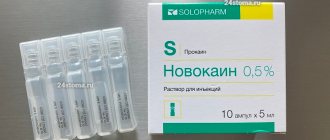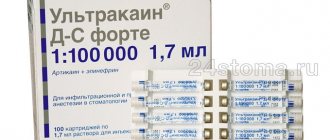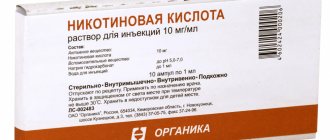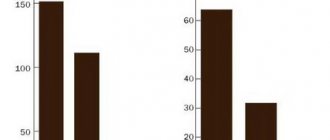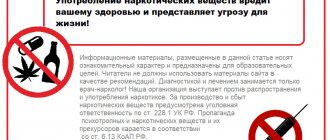Pharmacodynamics and pharmacokinetics
Platyphylline Hydrotartrate is characterized by a cholinolytic effect: by blocking M-choline receptors , it converts them into forms insensitive to acetylcholine . Due to the direct myotropic antispasmodic effect on the smooth muscles of the intestines, bile ducts, bronchi and eyes, it is considered a papaverine-like agent . In addition, it has a mild direct inhibitory effect on vascular smooth muscle, a calming effect on the central nervous system, especially on the vasomotor center, providing vasodilatory and hypotonic effects.
Platyphylline Hydrotartrate is well absorbed from the subcutaneous layer of the epidermis . However, the administration of large doses causes its accumulation in the tissues of the central nervous system in significant concentrations. It is excreted through the urinary as well as the digestive system.
Platiphylline hydrotartrate 2 mg/ml No. 10 solution for subcutaneous administration in the amp.
Instructions for medical use of the drug Platiphylline hydrotartrate Trade name Platiphylline hydrotartrate International nonproprietary name No Dosage form Solution for subcutaneous administration 2 mg/ml, 1 ml Composition 1 ml of the drug contains the active substance - platiphylline hydrotartrate - 2.0 mg excipients: water for injection up to 1.0 ml Description Transparent colorless liquid. Pharmacotherapeutic group Drugs for the treatment of functional intestinal disorders. Synthetic anticholinergic agents are esters with a tertiary amino group. ATC code A03AA Pharmacological properties Pharmacokinetics Easily passes through histohematic barriers (including the blood-brain barrier), cellular and synaptic membranes. When administered in large doses, it accumulates in the central nervous system in significant concentrations. Metabolized in the liver. It undergoes hydrolysis to form platinecin and platinecinic acid. Excreted by the kidneys and intestines. Does not accumulate. Pharmacodynamics M-cholinergic blocker, in comparison with atropine, has less effect on peripheral m-cholinergic receptors (the effect on smooth muscle cells of the gastrointestinal tract (GIT) and circular muscle of the iris is 5-10 times weaker than atropine). By blocking m-cholinergic receptors, it disrupts the transmission of nerve impulses from postganglionic cholinergic nerves to the effector organs and tissues innervated by them (heart, smooth muscle organs, exocrine glands); also suppresses n-cholinergic receptors (much weaker). The anticholinergic effect is more pronounced against the background of increased tone of the parasympathetic part of the autonomic nervous system or the action of m-anticholinergic stimulants. To a lesser extent than atropine, it causes tachycardia, especially when used in large doses. By reducing the influence of n.vagus, it improves cardiac conductivity, increases myocardial excitability, and increases minute blood volume. It has a direct myotropic antispasmodic effect and causes dilation of small blood vessels in the skin. In high doses, it inhibits the vasomotor center and blocks the sympathetic ganglia, as a result of which the blood vessels dilate and blood pressure decreases (mainly when administered intravenously). Weaker than atropine, it inhibits the secretion of endocrine glands; causes a pronounced decrease in smooth muscle tone, amplitude and frequency of peristaltic contractions of the stomach, duodenum, small and large intestine, a moderate decrease in gallbladder tone (in persons with hyperkinesia of the biliary tract); with hypokinesia, the tone of the gallbladder increases to normal levels. Causes relaxation of the smooth muscles of the uterus, bladder and urinary tract; Providing an antispasmodic effect, it eliminates pain. Relaxes the smooth muscles of the bronchi caused by increased tone of the n.vagus or cholinergic stimulants, increases the minute volume of respiration, inhibits the secretion of the bronchial glands; reduces sphincter tone. Stimulates the brain and respiratory center, and to a greater extent the spinal cord (in high doses, convulsions and depression of the central nervous system (CNS), vasomotor and respiratory centers are possible). Penetrates the blood-brain barrier. Indications for use - peptic ulcer of the stomach and duodenum (as part of combination therapy) - pylorospasm - cholecystitis - cholelithiasis - intestinal, renal and biliary colic Method of administration and dosage For peptic ulcer of the stomach and duodenum, to relieve attacks of spastic pain (intestinal, liver , renal colic), the drug is administered subcutaneously at 2-4 mg (1-2 ml of a 2 mg/ml solution). For course treatment (10-20 days), 2-4 mg is administered subcutaneously 2-3 times a day. The highest dose for adults: single – 10 mg, daily – 30 mg. Side effects - dryness of the oral mucosa, thirst - decreased blood pressure - tachycardia - mydriasis - paralysis of accommodation - intestinal atony - dizziness, headache - photophobia - convulsions - urinary retention - acute psychosis (in high doses) - pulmonary atelectasis Contraindications - increased individual sensitivity - pregnancy and lactation - angle-closure glaucoma - cachexia - severe atherosclerosis - degree II-III heart failure, arrhythmias, tachycardia - prostatic hyperplasia - liver and/or renal failure - pyloroduodenal stenosis - diaphragmatic hernia in combination with reflux esophagitis — paralytic ileus — intestinal atony — bleeding from the gastrointestinal tract — megacolon complicated by ulcerative colitis — elderly and senile age. - children under 15 years of age Drug interactions Enhances the sedative and hypnotic effects of phenobarbital, pentobarbital, magnesium sulfate. Other m-anticholinergic drugs, amantadine, haloperidol, phenothiazine, monoamine oxidase inhibitors, tricyclic antidepressants, and some antihistamines increase the risk of side effects. Antagonism with cholinesterase inhibitors. Morphine enhances the inhibitory effect on the cardiovascular system, monoamine oxidase inhibitors have positive chrono- and bathmotropic effects; cardiac glycosides - positive bathmotropic effect; Quinidine, procainamide – m-anticholinergic effect. For pain associated with smooth muscle spasms, the effect is enhanced by analgesics, sedatives, and tranquilizers; for vascular spasms - antihypertensive and sedatives. Special instructions Use with caution for diseases of the cardiovascular system, in which an increase in heart rate is undesirable (acute bleeding, atrial fibrillation, tachycardia, etc.), with elevated body temperature (it may further increase due to suppression of the activity of the sweat glands), achalasia of the esophagus and pyloric stenosis (possible decrease in motility and tone, leading to obstruction, retention of stomach contents), intestinal atony in elderly or debilitated patients, closed-angle and open-angle glaucoma, toxicosis, pregnant women, brain damage in children Reflux esophagitis, hiatal hernia, combined with reflux esophagitis (decreased motility of the esophagus and stomach and relaxation of the lower esophageal sphincter can slow gastric emptying and increase gastroesophageal reflux through the sphincter with impaired function). Diseases of the gastrointestinal tract accompanied by obstruction: achalasia and pyloric stenosis (possibly decreased motility and tone, leading to obstruction and retention of gastric contents). Intestinal atony in elderly or debilitated patients (possible development of obstruction), paralytic intestinal obstruction. Diseases with increased intraocular pressure: closed-angle glaucoma (mydriatic effect, leading to an increase in intraocular pressure, can cause an acute attack), open-angle glaucoma (mydriatic effect can cause a slight increase in intraocular pressure; therapy adjustment may be required), age over 40 years (risk of undiagnosed glaucoma). Nonspecific ulcerative colitis (high doses can inhibit intestinal motility, increasing the likelihood of paralytic ileus; in addition, the manifestation or exacerbation of a complication such as toxic megacolon is possible). Dryness of the oral mucosa (long-term use may cause a further increase in the severity of xerostomia). Liver failure (decreased metabolism) and renal failure (risk of side effects due to decreased excretion). Chronic lung diseases, especially in young children and weakened patients (a decrease in bronchial secretion can lead to thickening of secretions and the formation of plugs in the bronchi). Myasthenia gravis (condition may worsen due to acetylcholine inhibition). Autonomic (autonomic) neuropathy (urinary retention and paralysis of accommodation may increase), prostatic hyperplasia without urinary tract obstruction, urinary retention or predisposition to it, or diseases accompanied by urinary tract obstruction (including bladder neck due to prostatic hyperplasia) . Preeclampsia (possibly increased arterial hypertension). Brain damage in children (central nervous system effects may be enhanced). Down syndrome (possibly unusually dilated pupils and increased heart rate). Central paralysis in children (the reaction to anticholinergic drugs may be most pronounced). During treatment, it is necessary to regularly monitor blood pressure and pulse. During the treatment period, you should avoid drinking alcoholic beverages. Features of the effect of the drug on the ability to drive vehicles or potentially dangerous mechanisms It is necessary to refrain from driving vehicles and engaging in other potentially dangerous activities that require increased concentration and speed of psychomotor reactions. Overdose Symptoms: paralytic intestinal obstruction, acute urinary retention (in patients with prostate adenoma), paralysis of accommodation, increased intraocular pressure; dryness of the mucous membrane of the mouth, nose, throat, difficulty swallowing, speech, mydriasis (until the iris completely disappears), tremors, convulsions, hyperthermia, agitation, depression of the central nervous system, suppression of the activity of the respiratory and vasomotor centers. Treatment: forced diuresis; parenteral administration of m-cholinomimetics and cholinesterase inhibitors. For hyperthermia - wet wipes, antipyretics, for agitation - intravenous administration of sodium thiopental; for mydriasis - topically, in the form of pilocarpine eye drops. In the event of an attack of glaucoma, a 1% solution of pilocarpine is immediately instilled into the conjunctival sac every hour, 2 drops and subcutaneously - 1 ml of a 0.05% solution of Prozerin (neostigmine methyl sulfate) 3-4 times a day. Release form and packaging Solution for subcutaneous administration 2 mg/ml. 1 ml in neutral glass ampoules. 10 ampoules with instructions for medical use in the state and Russian languages and a knife for opening ampoules or an ampoule scarifier are placed in a cardboard box. 5 or 10 ampoules are placed in a blister pack made of polyvinyl chloride film or polyethylene terephthalate tape and aluminum foil or paper with a polyethylene coating or without foil, or without paper. 1 or 2 contour packages (5 or 10 ampoules each) together with instructions for medical use in the state and Russian languages and a knife for opening ampoules or an ampoule scarifier are placed in a cardboard pack. When packaging ampoules with a break ring or break point, do not insert a knife for opening ampoules or an ampoule scarifier. Storage conditions Store at temperatures from 10 to 25 0C. Keep out of the reach of children. Shelf life: 5 years. Do not use after expiration date. Conditions for dispensing from pharmacies By prescription 630028, Russia, Novosibirsk, st. Dekabristov, 275 tel., fax Registration certificate owner: OJSC "Novosibkhimpharm" 630028, Russia, Novosibirsk, st. Dekabristov, 275 tel.; fax Address of the organization receiving claims on the territory of the Republic of Kazakhstan from consumers regarding the quality of products (products) Representative office of Valenta Pharm OJSC in the Republic of Kazakhstan, Almaty, Abay Ave., corner st. Radostovtsa, 151/115, business office No. 702 Tel./fax, E-mail
Indications for use
Used for functional disorders of the digestive tract, including spasm of smooth muscles, gastric and duodenal ulcers , colic (intestinal, hepatic and renal).
In addition, the remedy is effective for diseases such as cholecystitis , bronchial asthma , hypertension or angina pectoris , bradycardia with arrhythmia , cerebral vasospasm , diarrhea , pain due to pancreatitis , biliary dyskinesia , inflammation of the esophageal mucosa.
It is used for poisoning with substances such as acetone , boric acid , strong acids, arsenic , reserpine .
Used in diagnostic ophthalmology (examination of the fundus and determination of eye refraction) and in the treatment of keratitis , iritis , iridocyclitis , various eye injuries, in rare cases it is used to dilate the pupil.
Instructions for use (Method and dosage)
Used orally, parenterally (subcutaneously, intravenously), rectally or topically.
Platiphylline Hydrotartrate is used intramuscularly if necessary - prescribed and adjusted by the attending physician, who is responsible for this prescription. The dose is determined depending on the symptoms and degree of the disease, route of administration and age of the patient.
Platyphylline Hydrotartrate is usually prescribed for the treatment of:
- Relief of acute ulcerative pain , intestinal, hepatic or renal colic, prolonged attacks of bronchial asthma , cerebral and peripheral vasospasms for adults - 1-2 ml 1 or 2 times a day.
- As an antispasmodic for adults - 1 ml daily for one month. The maximum single dose for an adult subcutaneously is 10 mg, no more than 30 mg per day.
Platyphylline hydrotartrate tablets 0.005 g
Release form: 5 mg tablets
Pharmacological group - m-anticholinergic
pharmachologic effect
- m-anticholinergic
- antispasmodic
- sedative
Ingredients – Crusader rhombolifolia rhizome alkaloid
Indications
- Hypertensive heart disease (hypertension primarily affecting the heart)
- Hypertensive (hypertensive) disease with predominant kidney damage
- Hypertensive (hypertensive) disease with predominant damage to the heart and kidneys
- Hypertensive (hypertensive) disease with predominant kidney damage without renal failure
- Hypertensive (hypertensive) disease with predominant kidney damage and renal failure
- Hypertensive (hypertensive) disease with predominant damage to the heart and kidneys, unspecified
- Hypertensive (hypertensive) disease with predominant damage to the heart and kidneys with (congestive) heart failure
- Hypertensive (hypertensive) disease with predominant damage to the heart with (congestive) heart failure
- Hypertensive (hypertensive) disease with predominant kidney damage with renal failure
- Hypertensive (hypertensive) disease with predominant damage to the heart without (congestive) heart failure
- Hypertensive disease with predominant damage to the heart and kidneys with (congestive) heart failure and renal failure
- Hypertension secondary to endocrine disorders
- Hypertension secondary to other renal lesions
- Pain in the abdomen and pelvis
- Diseases characterized by high blood pressure
- Asthma
- Asthma, unspecified
- Asthma with a predominance of an allergic component
- Secondary hypertension
- Secondary hypertension, unspecified
- Renovascular hypertension
- Cardiac ischemia
- Renal colic, unspecified
- Non-allergic asthma
- Peptic ulcer of unspecified localization
- Mixed asthma
- Essential (primary) hypertension
- Other secondary hypertension
- Other and unspecified abdominal pain
- Cholelithiasis
- Duodenal ulcer
- Stomach ulcer
Composition by components
- rhombifolius (Senecio rhombifolius), rhizome alkaloid
Description
Tartaric salt is an alkaloid found in ragwort.
Pharmacodynamics
Reduces the tone of the smooth muscles of the gastrointestinal tract (GIT), bile ducts, gallbladder, bronchi. Reduces the secretion of salivary, lacrimal, bronchial, sweat glands; increases heart rate (HR); dilates the pupil, causes moderate paralysis of accommodation and increased intraocular pressure. Less active than atropine, but at appropriate doses it is not inferior in effect to atropine and is better tolerated. It inhibits the cholinoreactive systems of the autonomic nerve nodes more strongly than atropine. It has a calming effect on the central nervous system (CNS), especially on the vasomotor centers.
Application
Renal, hepatic, intestinal colic, peptic ulcer of the stomach and duodenum, bronchial asthma, spasm of blood vessels (arterial hypertension, angina), spasms of cerebral vessels. In ophthalmic practice - to dilate the pupil.
Dosage regimen
To relieve acute ulcerative pain, intestinal, hepatic, renal colic, 1-2 ml of a 0.2% solution is injected under the skin. For a course of treatment (10-5-20 days), 0.003-0.005 g or 10-15 drops of a 0.5% solution are prescribed orally (before meals) 2-3 times a day; or 1-2 ml of 0.2% solution is administered subcutaneously. Rectally, 0.01 g 2 times/day or in a microenema, 20 drops of 0.5-1% solution 2-3 times/day. In ophthalmic practice, 1% solution is used for diagnostic purposes and 2% solution for therapeutic purposes. Children are prescribed 0.0002-0.003 g per dose, depending on age. Maximum dose for adults orally and subcutaneously: single dose - 0.01 g, daily dose - 0.03 g.
Side effects
Dry mouth, accommodation paresis, tachycardia, difficulty urinating, pupil dilation, central nervous system stimulation.
Contraindications
Glaucoma, hepatic-renal failure.
Overdose
Clinical picture of an overdose of Platiphylline Hydrotartrate:
- dry mouth;
- increase in heart rate and decrease in blood pressure;
- dilated pupils and lack of reaction to light;
- paresis of accommodation;
- acute difficulty urinating;
- intestinal paresis;
- convulsions;
- dyspnea;
- hyperthermia and redness of the skin;
- stimulation of the central nervous system with its subsequent depression;
- various disturbances of consciousness, including hallucinations ;
- respiratory failure.
Measures taken in this case: forced diuresis, use of cholinesterase (for example Physostigmine , Galantamine or Proserin ) to weaken intestinal paresis and reduce tachycardia.
If the excitation of the central nervous system is moderate and the convulsions are not pronounced, then it is recommended to use magnesium sulfate , in severe conditions - sodium hydroxybutyrate , oxygen therapy , and artificial ventilation .
Platyphylline hydrotartrate
Hypersensitivity. Caution. Diseases of the cardiovascular system in which an increase in heart rate may be undesirable: atrial fibrillation, tachycardia, CHF, coronary artery disease, mitral stenosis, arterial hypertension, acute bleeding;
thyrotoxicosis (possibly increased tachycardia);
increased body temperature (may further increase due to suppression of the activity of the sweat glands);
reflux esophagitis, hiatal hernia, combined with reflux esophagitis (decreased motility of the esophagus and stomach and relaxation of the lower esophageal sphincter can slow down gastric emptying and increase gastroesophageal reflux through the sphincter with impaired function);
gastrointestinal diseases accompanied by obstruction: achalasia and pyloric stenosis (possibly decreased motility and tone, leading to obstruction and retention of gastric contents);
intestinal atony in elderly or debilitated patients (possible development of obstruction), paralytic intestinal obstruction (possible development of obstruction);
diseases with increased intraocular pressure: closed-angle (mydriatic effect, leading to an increase in intraocular pressure, can cause an acute attack) and open-angle glaucoma (mydriatic effect can cause a slight increase in intraocular pressure; therapy adjustment may be required), age over 40 years (risk of undiagnosed glaucoma );
nonspecific ulcerative colitis (high doses can inhibit intestinal motility, increasing the likelihood of paralytic ileus; in addition, the manifestation or exacerbation of such a severe complication as toxic megacolon is possible);
dry mouth (long-term use may further increase the severity of xerostomia);
liver failure (decreased metabolism) and renal failure (risk of side effects due to decreased excretion);
chronic lung diseases, especially in young children and weakened patients (a decrease in bronchial secretion can lead to thickening of secretions and the formation of plugs in the bronchi);
myasthenia gravis (the condition may worsen due to inhibition of the action of acetylcholine);
autonomic (autonomic) neuropathy (urinary retention and paralysis of accommodation may increase), prostatic hypertrophy without urinary tract obstruction, urinary retention or predisposition to it, or diseases accompanied by urinary tract obstruction (including bladder neck due to prostatic hypertrophy) ;
gestosis (possibly increased arterial hypertension);
brain damage in children (CNS effects may be enhanced);
Down's disease (possibly unusual pupil dilation and increased heart rate);
central paralysis in children (the reaction to anticholinergic drugs may be most pronounced).
Interaction
- Platiphylline Hydrotartrate is able to prolong the hypnotic effect of phenobarbital , sodium etaminal , magnesium sulfate ;
- capable of blocking proserin ;
- may increase the effect of H2-histamine blockers , Digoxin and Riboflavin ;
- may enhance mydriasis with adrenergic agonists and nitrates , increasing intraocular pressure;
- compatible with caffeine for cerebral vascular spasms;
- compatible with Cordiamin and Diafillin ;
- with Morphine eliminates bradycardia , nausea, vomiting;
- with Verapamil eliminates bradycardia .
Analogs
Level 4 ATC code matches:
Disflatil
Aprofen
Mint tablets
Spasmol
Kuplaton
Espumisan
Espumisan Baby
Espumisan L
Espumisan 40
No-Shpa
Drotaverine Hydrochloride
Bobotik
Dill water
Pepsan-R
Sub Simplex
Spasmomen
Meverin
Metacin
Niaspam
Sparex
- Platyfillin;
- Infacol;
- Enterospasmil.
